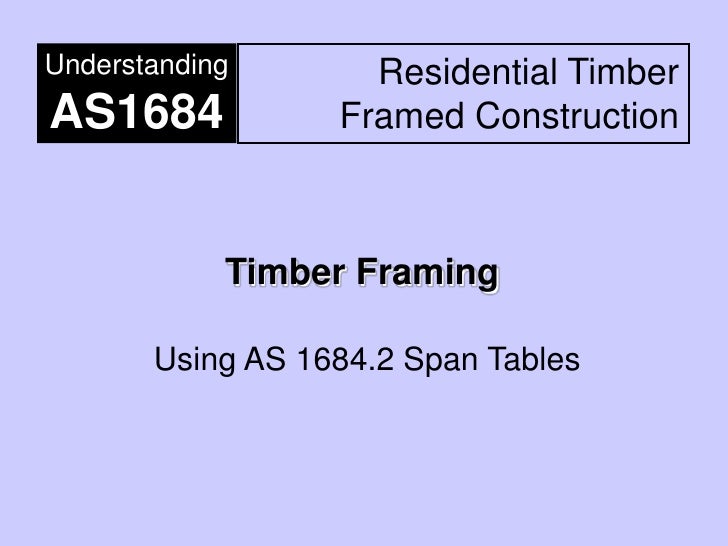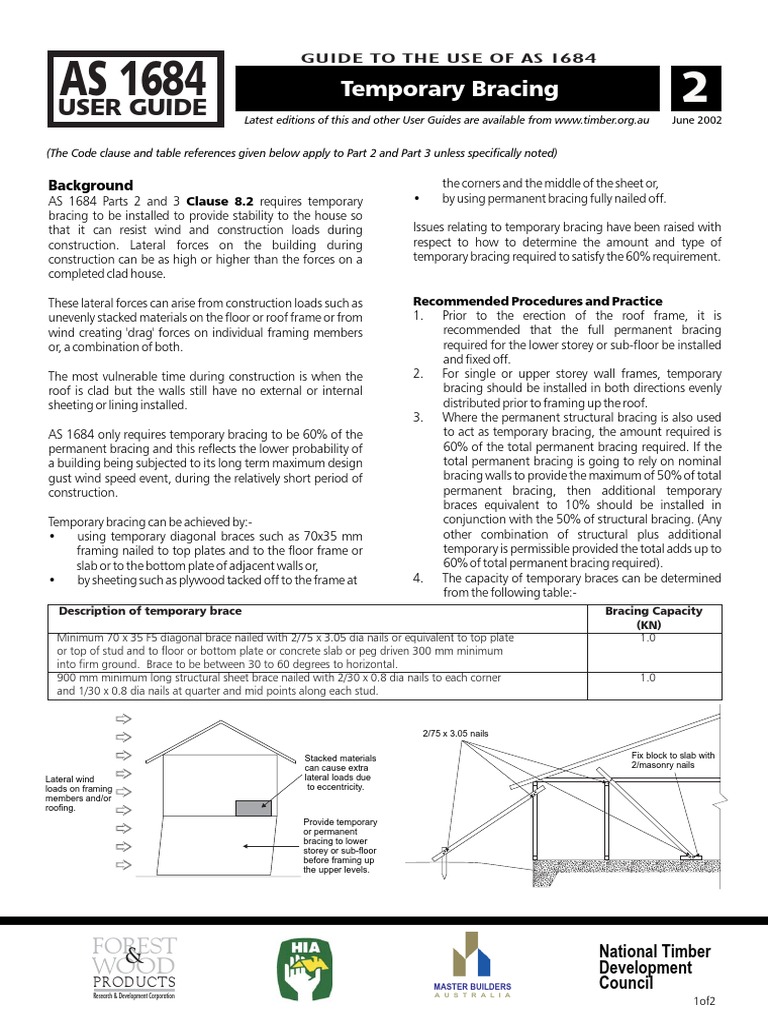
PPT TIMBER FRAMING USING AS 1684.2 SPAN TABLES PowerPoint Presentation ID3299684
As 1684.4-2010 Residential Timber-framed Construction Simplified - Non-Cyclonic Areas - Free download as PDF File (.pdf), Text File (.txt) or read online for free. Australian Standards(r) are living documents that reflect progress in science, technology and systems. To maintain their currency, all Standards are periodically reviewed, and new editions are published.

Using span tables as1684 2
AS 1684.2—1999 Residential timber-framed construction Building Code of Australia primary referenced Standard This is a free 9 page sample. Access the full version online. (Incorporating Amendment Nos.1, 2, 3 and 4) This Australian Standard was prepared by Committee TM/2, Timber Framing. It

Typical arrangement of timber framing, Source AS1684.3 Download Scientific Diagram
Home. AS 1684 Part 1 - Design criteria. AS 1684.1 sets out the basis for calculating timber sizes and forces to be resisted by tie-down and bracing. It provides a standard reference for designers and product manufacturers to produce compatible engineering solutions. Details of the standards must be obtained from Standards Australia.

Using span tables as1684 2 Timber frame construction, Roof construction, Roof shapes
This Standard specifies requirements for building practice and the selection, placement and fixing of the various structural elements used in the construction of timber-framed Class 1 and Class 10 buildings as defined by the National Construction Code. The provisions of this Standard also apply to alterations and additions to such buildings.

AS1684 2 Guide PDF Framing (Construction) Wall
AS 1684 - Four parts AS 1684 Residential Timber Framed Construction has four parts: Part 1 relates to design criteria that can be used as a basis for the preparation of span tables and design data for the other parts. This is the document commonly used by engineers

Old/New Codes AS 1684
Preview AS 1684.2:2021 Current Add to Watchlist Residential timber-framed construction Non-cyclonic areas Available format (s): Hardcopy, PDF 1 User, PDF 3 Users, PDF 5 Users, PDF 9 Users Language (s): English Published date: 25-06-2021 Publisher: Standards Australia Abstract General Product Information History

Using span tables as1684 2 Timber frame construction, Roof construction, Roof battens
繁體中文. This Standard specifies requirements for building practice and the selection, placement and fixing of the various structural elements used in the construction of timber-framed Class 1 and Class 10 buildings as defined by the National Construction Code; the provisions of this Standard also apply to alterations and additions to such.

PPT TIMBER FRAMING USING AS 1684.2 SPAN TABLES PowerPoint Presentation ID3299684
AS 1684 Residential Timber Framed Construction is a four-part Australian Standard covering design criteria, building practices, tie-downs, bracing and span tables for timber framing members. It is also referred to as the Timber Framing Code.

Using span tables as1684 2 Roof construction, Ridge board, Timber frame construction
Full Description. AS 1684.4 2010 specifies requirements for the building industry with procedures that can be used to determine building practice, to design or check construction details, and to determine member sizes, and bracing and fixing requirements for timber-framed construction in non-cyclonic wind classifications N1 and N2.

Using span tables as1684 2 Timber Frame Construction, Building Construction, Roof Framing
Overview of the Standard AS 1684 Part 4 provides the requirements for building practices and the selection, placement and fixing of structural elements used in timber framing for Class 1 (houses) and Class 10 (i.e. garages) for both new buildings and alterations for wind classifications up to N2.

General Usage and Applications of AS1684 Residential Timber Framed Construction (Webinar
Australian standards Changes to the Timber Framing Code Changes to the Timber Framing Code The NCC 2022 will bring in to affect the updated AS 1684.2:2021 and AS 1684.3:2021 timber framing code changes, here is what you need to know on the updates. Thursday, 08th December 2022

Using span tables as1684 2 Timber frame construction, Span, Roof construction
Overview Download & View As 1684.2-2010 Residential Timber-framed Construction.pdf as PDF for free. More details Words: 83,578 Pages: 281 Preview Full text Related Documents As 1684.2-2010 Residential Timber-framed Construction.pdf [2nv8r3momolk]..

Using span tables as1684 2 Roof framing, Timber frame construction, Rafter
This Standard specifies requirements for building practice and the selection, placement and fixing of the various structural elements used in the construction of timber-framed Class 1 and Class 10 buildings as defined by the National Construction Code. The provisions of this Standard also apply to alterations and additions to such buildings.

Using span tables as1684 2 Roof construction, Timber frame construction, Roof framing
This Standard specifies requirements for building practice and the selection, placement and fixing of the various structural elements used in the construction of timber-framed Class 1 and Class 10 buildings as defined by the Building Code of Australia and within the limitations given in Clause 1.4. The provisions of this Standard also apply to.

Using span tables as1684 2
AS 1684 specifies requirements for building practice and the selection, placement and fixing of the various structural elements used in the construction of timber-framed Buildings as defined by the Building Code of Australia and within the limitations given in Clause 1.6. The deemed to satisfy provision describe the requirements.

AS1684.1 Residential TimberFrame Construction PDF Wall Framing (Construction)
Australian Building Codes Board Australian Timber Importers' Federation Building Research Association of New Zealand CSIRO, Building, Construction and Engineering. Class 1 and Class 10 buildings as defined by the Building Code of Australia. This Standard should be read in conjunction with AS 1684.2, AS 1684.3 and AS 1684.4, the